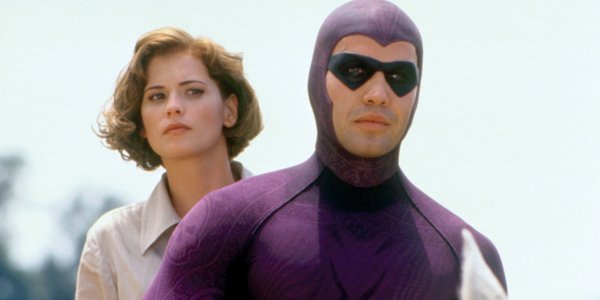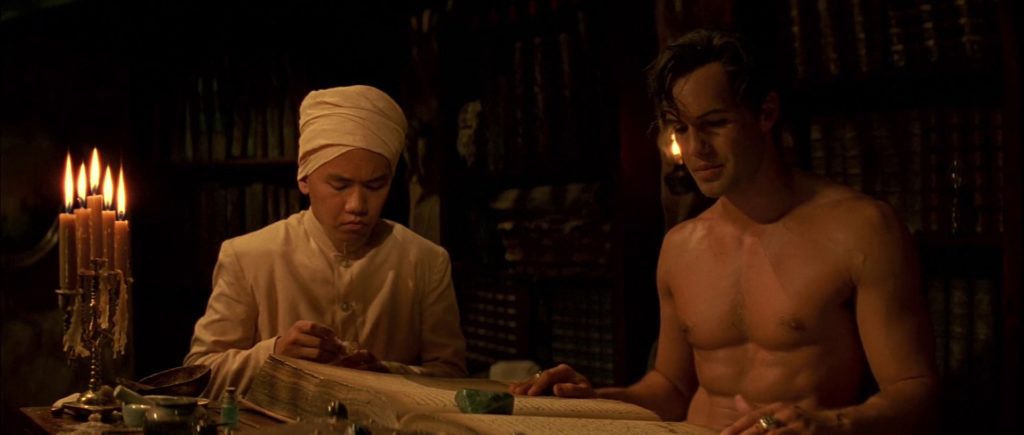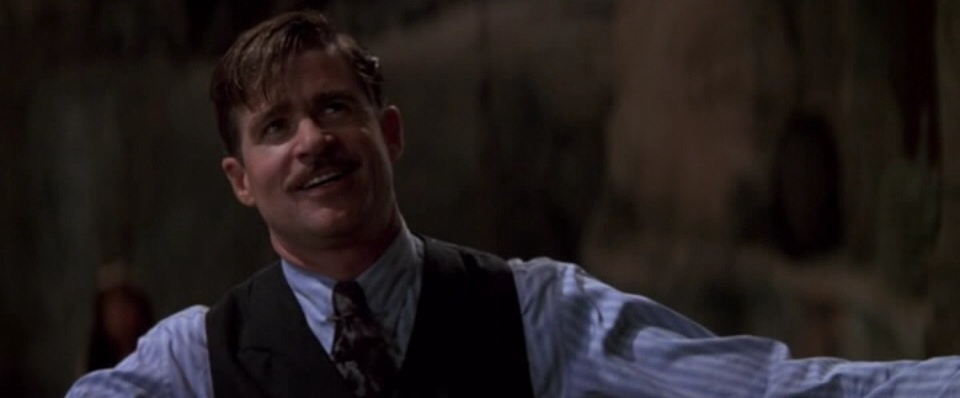This post was written as part of The Spirit of ’96, a yearlong celebration of the 300+ films that were released on American screens in 1996, written by some of the film buffs who love them best. See all the contributions here.
Stop me when this sounds too ridiculous. Deep in the jungles of south-east Asia dwells a legendary hero, an immortal being who can be killed but never truly die. Clad in purple from head to toe, armed with twin handguns and a skull ring, and with his faithful wolf by his side, he sallies forth to defend the innocent, protect the peace and vanquish evildoers. He is implacable, inscrutable and completely indifferent to the demands of camouflage in densely forested areas.
This, believe it or not, is the premise of The Phantom, a two-fisted tale of golden age heroics that landed with a resounding thud at the box office. Yet over the past two decades it’s become something of a curiosity: a goofy but endearing mix of old-fashioned derring-do and hammy charm that paved the way for films like the 1999 version of The Mummy. And for impressionable young minds exposed to it at precisely the right age, The Phantom was the gateway to the Indiana Jones School of grand adventures.
After a fleeting prologue we find ourselves in the Bangalla Jungle in 1938, where a group of disreputable-looking fortune hunters are searching for a silver skull of immense power. (Long before skulls derailed the Indiana Jones franchise, they were cheerful MacGuffins in The Phantom.) They ransack an ancient tomb and draw the attention of the Ghost Who Walks, more commonly known as the Phantom (Billy Zane), who has been tasked with protecting the skull and its two fellows from villains. The tomb raiders work for Xander Drax (Treat Williams), an egomaniac millionaire bent on world domination via supernatural means. When explorer Diana Palmer (Kristy Swanson) volunteers to dig up more information on Drax for her uncle’s newspaper, she gets caught up in the Phantom’s race to save the world by finding the remaining skulls before Drax does.
To enjoy The Phantom, it would help if you already appreciate two things: pulp and cheese. The film is a mid-nineties throwback to the breezy thirties heyday of pulp, when Lee Falk created the original Phantom comic strip for King Features Syndicate (incidentally also the home of Flash Gordon). Take our hero. With his lantern jaw, insouciant smile and occasional curl of dark hair dangling fetchingly over one eye, Billy Zane looks as if he just stepped out of a period serial. Rare is the man who can sport a purple spandex suit without endangering his dignity; rarer still is the man who can do so whilst dropping from a nose-diving plane onto a galloping horse. Zane is to the manner born, having just enough fun to make the implausible not only credible but thrilling. In one scene, he sneaks onto a ship to rescue Diana, flying out of a laundry chute to the bewilderment of both Diana and her jailer. A few punches later, the prisoner is free but still has reservations about her rescuer: “Your dog’s a wolf,” she says incredulously. “I know,” he replies, beaming, as if wolves were common pets outside Westeros. It’s a cheesy exchange and thanks to Zane, thoroughly charming. The only scenes in which the Phantom’s nonchalance slips are those with his late father (Patrick McGoohan), the previous Phantom and now a literal, and rather crotchety, ghost. McGoohan possessed one of the iciest stares this side of Toshiro Mifune—it’s no wonder even a superhero quails under it.
Squaring off against the Phantom(s) is Xander Drax, a criminal mastermind with a huckster’s toothy grin and a megalomaniacal streak large enough to blot out the sun. Williams plays him like a televangelist gone wrong, gleefully taking breaks from dispatching his victims to pontificate on the occult. Even more entertaining is Catherine Zeta Jones’ devious pilot, Sala, who sashays onto the screen in a clinging fur-collared jumpsuit and proceeds to steal Diana’s boots, a crucial scrap of evidence, and the film. Watching her smirk her way through the mayhem is one of the movie’s abiding pleasures.
Alas, there are also obvious shortcomings. First, The Phantom makes few allowances for newcomers. The Ghost Who Walks isn’t Superman or Spider-Man and can’t count on the same audience recognition. Yet the prologue which introduces the Phantom legend is barely a minute long and is preceded by the title card, “For those who came in late”—a sentiment which seems strangely hostile to the neophytes the film was supposed to attract. The plot also combines three disparate storylines from the comics into a tangled jumble that probably left the non-initiated scratching their heads. As for the cast, no one lets the side down more than Kristy Swanson, who tries for a spunky cross between Katharine Hepburn and Jean Arthur and ends up sounding like a whiny Valley girl in fancy dress. The juxtaposition with Zeta Jones does Swanson no favours either; Sala is duplicitous, but at least she’s never dull.
Still, there’s much to be enjoyed, including beautiful location photography and a soaring David Newman score that provides approximately half the film’s thrills. Besides, perfection isn’t really the point of The Phantom. Fun is. In an age of increasingly portentous comic book heroics, with the Avengers fighting a civil war and the X-Men grimly facing Apocalypse, The Phantom feels like a tonic: light-hearted, bright and breezy. Sometimes, that’s all you need.




Leave a Reply